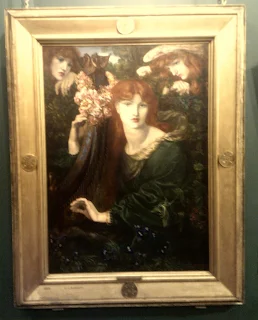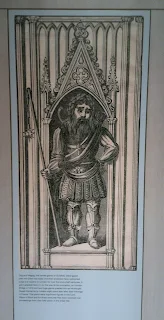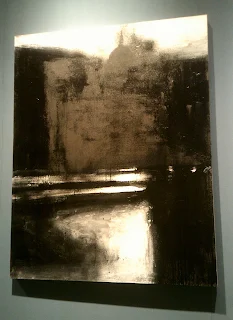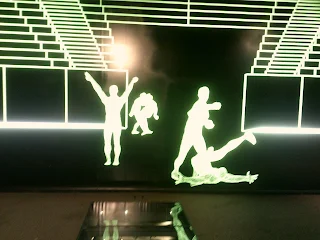When Miss Elaineous heard of the existence of a Roman amphitheatre right here in London, some nosey-parkering was definitely in order.
The Guildhall Art Gallery is in the heart of the City of London and was first built in 1885 to display the City of London Corporation's increasing art collection. It was almost totally destroyed by fire during an air raid in May 1941. Fortunately, many works had been removed to underground storage facilities in Wiltshire, but some 184 pieces, including drawings, watercolours, prints and sculpture were lost. A temporary structure stood on the site for many years until 1985, when the City decided to redevelop the site and add a lower art gallery. In 1987 the remains of the original art gallery were demolished, and in 1988 the startling discovery of a Roman amphitheatre meant that the new building had to be redesigned, to incorporate this amazing feature of extreme historical importance. The new gallery was finally opened to the public in 1999, and the amphitheatre in 2002.
The art gallery houses some 250 ever-changing works of significant art and sculpture, as well as showing temporary exhibitions. The static collection mainly incorporates the chief artistic influences of the Victorian period, including Orientalism, Classicism and works by the Pre-Raphaelite brotherhood.
I love the City of London- nowadays it's a real mixture of old buildings juxtaposed with shiny new creations.
You see this building as you exit Bank station. I've seen it described as a 'wedding cake'!
The view down to King William Street...
The Royal Exchange with the Leadenhall Building, aka 'The Cheesegrater' in the background...
Mansion House...
No.1 Poultry...
Side views of the Bank of England...
Maybe I should live here, nudge nudge, wink wink...
The Guildhall Art Gallery...
The City of London Police Museum is opposite and I'll be giving this a visit in the near future...
The church of St Lawrence Jewry...
I took photographs of some of my favourite pieces. This gallery allows photography, unlike some who are way too precious about it.
This 2012 piece is called Plenty and Progress and is by Mark Titchner (b.1973). You can see an orange and leopard print vain old tart reflected in it!
La Ghirlandata (The Garlanded Woman), 1873, by Dante Gabriel Rossetti (1828-1882).
I love the Pre-Raphaelites. A friend of mine described them as, 'Rampant shaggers- and they painted some lovely paintings too!'
George Herbert at Bemerton, 1860, by William Dyce (1806-1864). I liked the detail in the leaves.
The Garden of Eden, 1901, by Hugh Goldwin Riviere (1868-1956). This is part of a series of works on display (by different artists) depicting the old-fashioned rituals of courtship, which seem very irrelevant today. Mind you, even in the 21st century I've met men that are w-a-a-a-y too formal...
The Execution of Lady Jane Grey, 1833, by Paul Delaroche (1797-1856). Poor girl.
These are modern stained glass decorations by Stella Timmins. They were commissioned in 2002 to commemorate the Queen's Golden Jubilee.
The view outside through the gauze window blinds...
Sun and Moon Flowers, 1890, by George Dunlop (1835-1921).
The Music Lesson, 1877, by Frederic Leighton (1830-1896).
I've been to his stunning artist's house in Holland Park, west London. Here a a couple of PDFs of Leighton House Museum- photography was definitely not allowed there!
This is the entrance hall...
The stairway...
Moving on, and there's an exhibition of tiles and plates by ceramic artist William de Morgan (1839-1917). A friend of William Morris, he designed tiles, stained glass and furniture for Morris & Co. from 1873-1962. This exhibition also looks at how mathematics is applied to design in the form of symmetry and pattern.
We come to a historical section and mythical figures Gog and Magog are the guardians of the City of London.
A copy of the Magna Carta...
There was a temporary exhibition of Victorian landscapes. This one is by John Constable (1779-1837) and is an oil sketch called Salisbury Cathedral from the Meadows. It was painted between 1829-31 and he's worked in a kind of frenzied attack, which you can see from his almost violent brush strokes. This painting is thought to reflect Constable's state of mind as his wife had died the previous year.
Echoes of a Far-Off Storm, 1890, by John Brett (1819-1907).
The Churchyard at Bettws-y-Coed, 1863, by Benjamin Williams Leader (1831-1923).
The Meeting of the Avon and the Severn, 1826, by Patrick Naysmith (1787-1831).
I loved the simplicity of this 1968 work called A London Story, by Mark Boyle (1934-2005).
Landscape 715, 2003, by John Virtue (b.1947). I loved the sheer anger that appears to have gone into this striking piece!
I was already in the basement, but now I had to take a short walk down into the bowels of the building to see the amphitheatre. The Romans established Londinium around AD43, and within 30 years were thought to have constructed a wooden amphitheatre, which received a major facelift at the beginning of the second century.
It is certainly atmospheric: with realistic crowd noises piped in and the green lighted seating and figures giving us some idea of a sense of perspective. The reason it's so subterranean is that population causes the ground level to rise. We walk in via what would have been the eastern gate.
These holes are thought to be the site of what was an iron gate, which was maybe used for holding the fighting slaves or animals.
Illuminated superimposed fighters.
There were intact sewers on the ground under glass.
And finally, we have to continue with the lavatorial theme- the toilets have been named 'the best in London!' They were certainly clean and impressive.
Vain old tart...
Even this shelf has been given some Roman inspiration...
I will return when I come to visit the police museum.
TTFN
The Miss Elaineous
XXXXXXXXXXXXXXXXXXXXXXXXXX
XXXXXXXXXXXXXXXXXXXX



















































